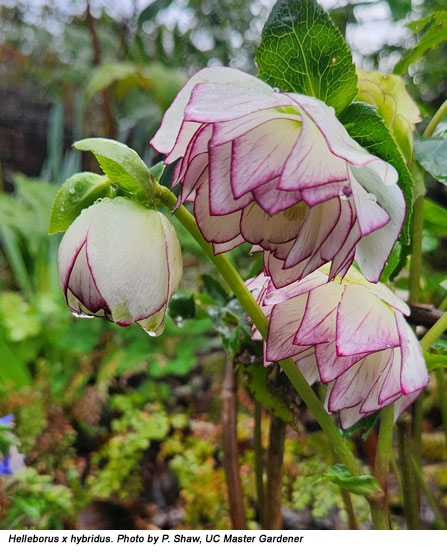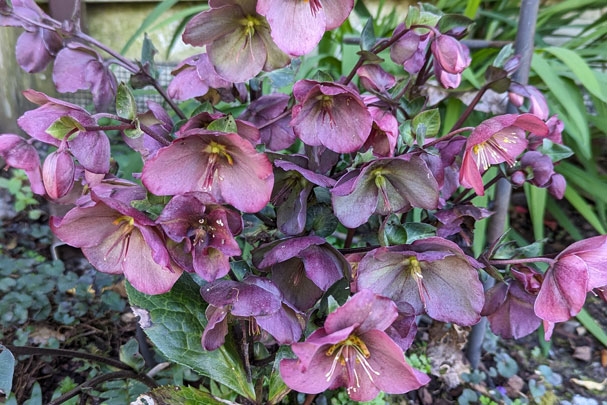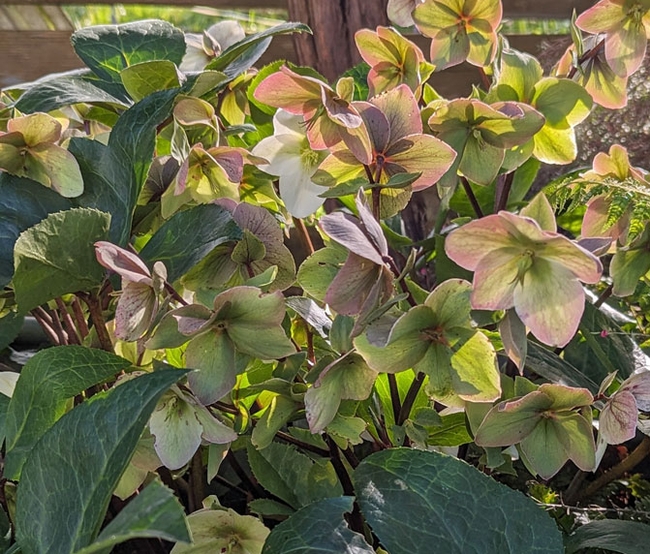
The Lenten rose has many attractive features: easy to cultivate, hardy, long-lived, and evergreen. Flowers emerge in the dead of winter and continue a showy display for several months. Flowers come in a variety of colors and styles. Blooms can make good cut flowers, and their seed heads add interest to dried floral arrangements. Hellebores, like other members of the Ranunculaceae family, have alkaloids in the leaves and seeds and can cause mild dermatitis in sensitive gardeners; be sure to wear gloves when working around hellebores. These same alkaloids make the leaves undesirable to deer, rabbits, moles, and voles. Hellebores are extremely frost-hardy and very tolerant of dry conditions once established. They are summer dormant, and they require little attention. What's NOT to like about this plant? It is certainly worth planting in our Northern California coastal gardens.
Lenten roses are an outstanding plant for adding color and texture to the ornamental shade garden. They grow in areas between deciduous shrubs and under trees or naturalize in woodland areas. They can be the stars of the early spring garden as specimen plants or mixed with other spring bulbs. Attractive in the summer, the coarse, leatherlike foliage makes a good backdrop to more delicate shade plants. They are also excellent for planting on a hillside above a path where the downward-facing flowers can be viewed from below.
Mature plants can form clumps that are 18” to 24” tall and 24” to 30” wide. The glossy, deep green foliage can vary in color and shape, even within the same hybrid. The leaves are divided into 7 to 9 segments with an umbrella-like shape held up on a woody stem. The toothed, leathery foliage remains attractive throughout the growing season, remaining evergreen in mild climates.
FLOWERS
Gardeners are most attracted to the hellebore for its early flowers, which can be seen starting in late December or early January/February and last for 2 to 3 months. Available in both single and double forms, it is available in a rainbow of muted colors, ranging from apple green and chartreuse to ivory, mauve, eggplant, and wine.
Flower buds form during the previous summer, and the flower spikes emerge from the underground rhizome in late winter. Mature plants often have 50 or more flowers per plant.
Flowers have five petal-like sepals (a modified calyx) surrounding a ring of small, yellowish-green, tubular nectaries in an open, bell shape. The nectaries are the petals modified to hold nectar. Inside the ring of petals, there are numerous stamens and several pistils. After the flower is pollinated, the petals and stamens fall off, but the sepals remain on the plant for 1-2 months or more (probably contributing to seed development).
Flowers are often followed by unusual seed pods that offer ornamental interest and can produce viable seeds if left on the plant. The carpels eventually dry and split to release the bean-shaped, shiny black seeds, each with a white elaiosome that becomes wrinkled with age. Seeds are self-planted when ripe and can slowly naturalize in the garden.
CULTURE and PROPAGATION
Hellebore does best in partial shade to full sun and well-drained, humus-rich, fertile garden soil. They are relatively drought tolerant once established but do best with consistent moisture. They are very sensitive to soggy soil, so the site must have good drainage. This plant requires little maintenance. The previous season's leaves will be dried and tattered after the winter and are best cut off at the ground as the flowers emerge in the spring. Sprinkle with a fresh layer of compost around the base of the plants before the flowers emerge. Fertilize in Spring. Apply slug and snail bait as the flower spikes emerge.
Commercial plants are propagated from seed, division, or tissue culture, but germination is slow. It can take four or five
CUT FLOWERS
A lot has been written about the fickle nature of Hellebores as a cut flower, but everyone agrees that they are worth the effort. The flowers make exquisite small winter bouquets. Different methods are used to increase the water uptake of the immature stem with some success. However, the more mature blooms will last the longest. Basic floral conditioning techniques work. Cut blooms in the morning using a diagonal cut. Plunge stems into cool water up to the flower head and keep in a cool dark place for 24 hours or until ready to arrange. Stems can also be cut at an angle and dipped into boiling water for several seconds to seal the stem, or the stem can be scored vertically with a knife to increase water uptake. Place stems into cool water.
Possibly the best advice comes from Erin Benzakein, the owner of Floret Farms, in her book Cut Flower Garden, “Getting Hellebores to last as cut flowers is simple but requires you to have some self-control: you must select blooms at the proper stage; otherwise, they'll wilt within a few hours of picking. …you must wait until the blooms develop seedpods in the center. The more developed the seedpods, the sturdier the cut hellebore will be and the longer it will last. A very mature hellebore bloom will hold up, unscathed, out of water for an entire day, lending itself to wearable creations such as boutonnieres, corsages, and flower crowns.”

Resources:
Say hello to hellebores, January 28, 2018
https://www.floretflowers.com/say-hello-hellebores/
University of California, UC Master Gardener Program of Sonoma County, Hellebores
https://sonomamg.ucanr.edu/Plant_of_the_Month/Hellebores/
Wisconsin Horticulture, Division of Extension, Lenten Rose, Helleborus x hybridus
https://hort.extension.wisc.edu/articles/lenten-rose-helleborus-xhybridus/